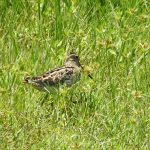LATHAM'S SNIPE
The Latham’s Snipe is a fascinating and somewhat elusive bird that captivates the interest of birdwatchers and conservationists alike. It is a migratory wader, named after the English ornithologist John Latham. With its mottled brown, black, and buff plumage, this bird blends seamlessly into its surroundings. The plumage provides exceptional camouflage, making this bird nearly invisible in its natural habitat. It has a notably long, straight bill, which it uses adeptly to forage in the mud. On average, the snipe measures about 29 to 32 centimeters in length.
The breeding season of Latham’s Snipe is a transcontinental tale of travel and endurance. During migration, Latham’s Snipe can fly non-stop for up to 8,000 kilometers. This incredible endurance makes them one of the more remarkable avian migrants.
During the Australian autumn, around March, these birds embark on a remarkable journey back to their breeding grounds in Japan and far-east Russia. The breeding habitat is typically marshy wetlands where they can find ample vegetation for cover.
Nests are artfully concealed on the ground amidst dense vegetation. Females lay about four eggs, which both parents help incubate. This period of nesting and rearing is crucial, and the snipe invests a lot in the protection and care of its offspring until they fledge.
With the approach of the northern winter, around September, Latham’s Snipe begins its migration back to the southern lands of Australia. This journey is particularly arduous, often involving non-stop flights over vast stretches of ocean.
In Australia, they are predominantly found in the south-eastern regions, including Tasmania. They favour wetlands, swamps, and sometimes even flooded grasslands. Their presence is often noted by their secretive nature, where they remain well-hidden, making them a delightful challenge for birdwatchers.
The diet of Latham’s Snipe is quite varied but largely consists of invertebrates such as insects, worms, and small crustaceans. They use their long bills to probe into soft mud, feeling for prey items rather than seeing them. This tactile feeding technique is quite effective in the murky environments they frequent.
Latham’s Snipe can live up to around 20 years in the wild, although much about their lifespan remains to be studied due to their elusive nature. They are currently listed as a species of least concern by the IUCN, but they face threats from habitat destruction and wetland drainage both in their breeding and non-breeding ranges.
Latham’s Snipe is not just a bird but a symbol of the intricate connections in our global ecosystem. Their life cycle, spanning continents and hemispheres, highlights the need for international cooperation in wildlife conservation and habitat preservation. Each sighting of this elusive bird reminds us of nature’s mysteries and the wonders that winged migration brings into our world.

